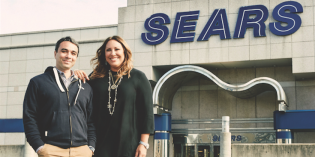As far as fi ghts go, this one has the potential to rock the industry hardest, if only because of the size of the combatants. Media companies such as CTV and Torstar have been building and growing internal creative teams for a few years now, and seeing healthy growth in the revenue they bring in for their efforts.
Metro, the newspaper distributed across Canada, opened its creative department in 2008 under Laila Hakim, director of its creative services, to be an additional resource for advertisers looking for something more than a quarter-page ad. “If we see a new product, we’ll jump on that and do a campaign or creative idea that we think will work in the Metro environment and give it to a [sales] rep to present to their client,” says Hakim.
Executions have ranged from cover wraps to unconventional print runs to page layouts that create unique interaction between editorial and advertising. Finding a square ad from Hakim’s team that fi ts neatly onto the ad grid is rare. This service isn’t limited to longstanding client relationships either.
Metro has lured new clients such as Victoria’s Secret, which used internally developed creative for its Canadian launch last August. Nor are the ad reps fi ghting an uphill battle. Over the last three years, marketers have seen such suffi cient returns from Metro’s work, that they now regularly approach the newspaper. Roots, Hallmark, TD and others have all used the service. While exact fi gures are under wraps, creative service revenue levels roughly doubled in 2009 from the year previous, and rose again approximately 50% in 2010. “Almost 10% of our annual sales come from this conceptual [work],” Hakim says.
CTV, meanwhile, has been leading the way in developing custom branded content programs—an area of interest to North American advertisers drawn by its promise of total brand control and narrowly cast demographic appeal. “Media companies appear to be adopting to the new world quicker than raditional agencies, and are becoming the friendliest rooms for us to hang out in,” says Brett Heard, creative director at Fresh Baked, the branded content studio behind VH Sauces’ Life Unjarred. Last year CTV created the online destination Get Fresh for Unilever’s Dove on its main network web property despite the similar name, Fresh Baked was not involved). It later helped shape Fora, a lifestyle hub for Johnson & Johnson’s Clean & Clear housed at MTV.ca.
“We’re building our business around providing as comprehensive a solution as we can for advertisers,” said Nancy McConnell, director of digital media sales at CTV, at the time of the Get Fresh launch. “One of the things that allows us to do that is our in-house team that lets us build these online destinations.” Hiring the art directors, designers and web specialists that ad agencies typically employ could position these media organizations as their potential competitors—if they weren’t so willing to work hand-in-hand with agencies.
Fora, for example, was developed in conjunction with media agency J3 (a division of Interpublic’s UM). CTV and Unilever invited PHD (Dove’s media AOR) to the table. And Metro goes to the same great lengths to keep things friendly. Hakim says for every idea that she’s given the gohead to develop erself, there’s one that is handed over to the agency of record.
“We’re okay with it,” she says. “The end result is that they’re advertising with us. It doesn’t matter how it happens. We’re here to inspire creative within our paper… Our intent is to work with the ad agencies, not take away from them. You don’t want to cut off your nose to spite you face.” Is this yet another xample of Canada’s deferential character? Are we being too nice? Ron Tite believes its something else entirely. “It’s not that we’re too nice, it’s that we’re too small,” says the former creative director at Sharpe Blackmore Euro RSCG who is now an independent consultant and public speaker.
“There are only so many media dollars available in this country. No one can afford to piss off one media agency.” In the U.S., size is not an issue and things are far less cordial. Last year, Condé Nast, publisher of Vogue, GQ and a full rack of other high-profi le magazines, launched CND Studio, an aggressive effort to create client advertising for any media property—even those outside Condé Nast. Having spent years crafting a number of custom ad projects for big-name advertisers, it just seemed a natural evolution to Drew Schutte, who launched CND Studio as the chief revenue offi cer for the digital group.
“In the digital world, there are these terms, ‘co-opetition,’ or ‘frenemy,’” he told Ad Age last April, “so you’re very used to working in a more transparent way. You’re working with people who on another day might be your competition. So the way we saw it, it was an opportunity.” Fashion brand Kenneth ole was CND Studio’s fi rst client. It developed online “Style Guide” videos for various web and social media properties. This was not the fi rst time a media company had developed ad creative, but the fact that this one was willing to play ball in the broader agency world and sell expertise beyond its own roperties is part of a sea change in how American media companies address the advertising world. Meredith, for example, has been acquiring digital agencies for more than four
years, and Hearst followed suit with the US$325 million acquisition of iCrossing last summer. For now, Canada remains neutral round where everyone gets a turn. Guessing what it will take to lead media owners to a more American model and a potential fight with agencies is best left to those with revenue projections. But even if the carrot is unknown, one possible stick could be an international initiative launched by a foreign owner like Metro International SA, which owns Metro internationally and operates in Canada through a partnership with Torstar. It is not bound by Canada’s small-market worries. It has global scale.
“You can never say never,” Hakim says in response to questions about the future of her business unit. “If it’s something Metro International wants to do across the board, it would be fantastic.”









